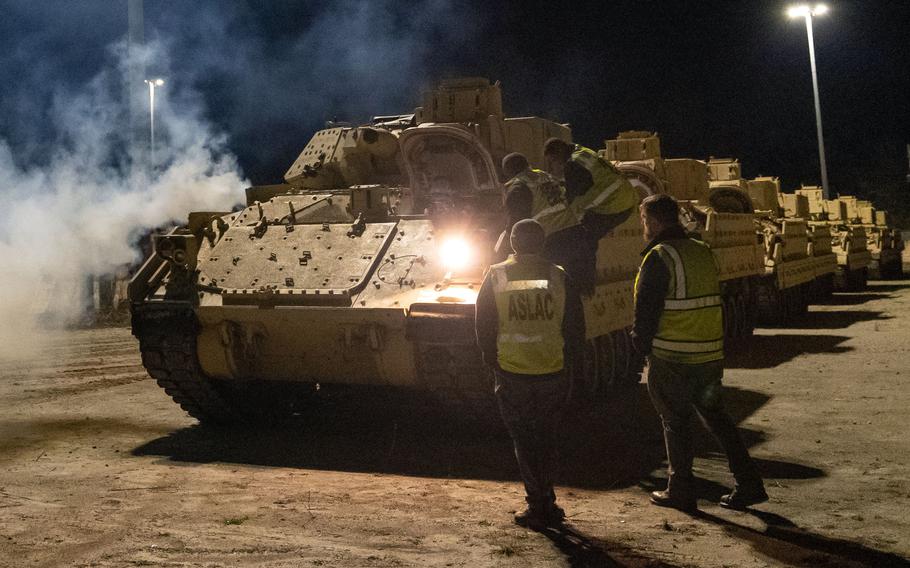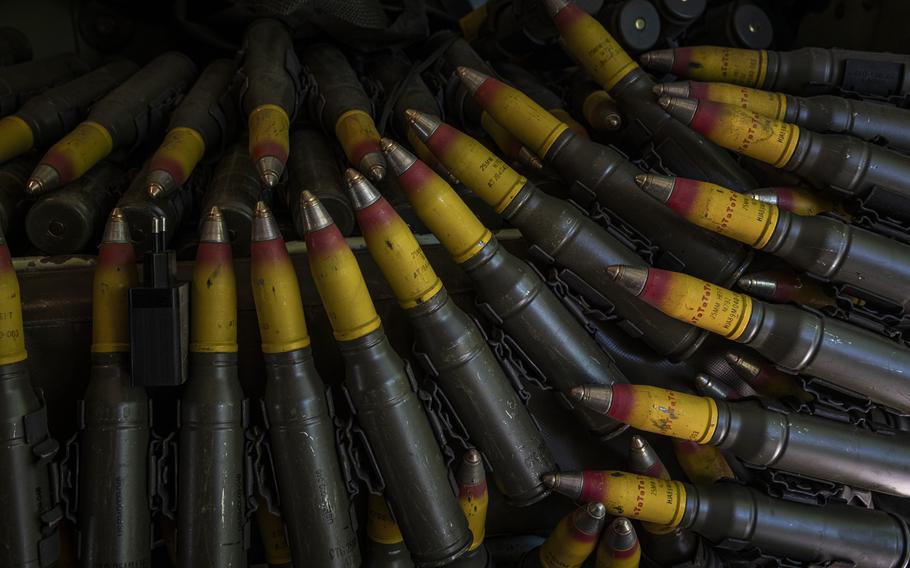Europe
‘Ram him’: How Ukraine is pushing US combat gear to the extreme
The Washington Post June 12, 2024

Drivers load Bradley Fighting Vehicles onto a ship in North Charleston, S.C., Jan. 25, 2023. (Oz Suguitan/U.S. Transportation Command)
The Ukrainians’ radio crackled with an urgent announcement: A Russian vehicle stacked with infantry troops was lurking in a forest and had to be taken out.
The mission went to Viktor, the 40-year-old commander of an American-made Bradley Fighting Vehicle, whose crew roared down the main road in the village of Sokil, in eastern Ukraine, where the Kremlin has gained ground this year.
The Russians emerged from the trees, and for a few chaotic seconds, the two vehicles barreled toward each other while firing their heavy guns — as if they were jousting. A soldier fell from the speeding Russian vehicle. Viktor’s took a catastrophic hit to its targeting system, disabling the main weapon.
“Ram him,” Viktor recalled instructing his driver.
The May 31 exchange, captured on drone video that subsequently went viral online, underscores how Kyiv has used U.S.-provided Bradleys in unique and extreme ways to work around its depleted artillery stocks and manpower shortages, soldiers and analysts said. Edited video of the incident was published by the Ukrainian Defense Ministry.
After being provided to Ukraine last year, the U.S. Bradleys, each weighing about 28 tons, were first used as battering rams to punch through Russian defenses during last year’s failed counteroffensive. But now they are being dispatched to hunt and kill other armored vehicles, to rescue wounded troops and as a mobile gun to rake enemy positions, observers said.
In the fall, Viktor’s unit, the 47th Separate Mechanized Brigade, and its Bradleys moved east to Donetsk to fight back against the Russians in the strategic town of Avdiivka, which Moscow’s forces ultimately captured. His team has undertaken all of these missions and more, he said, recounting, too, how they employed the Bradley’s firepower to destroy a Russian tank and shred a scout vehicle.
“It blew up very beautiful,” he said. “It burned fast, like a match.”
Viktor spoke with The Washington Post on the condition that only his first name be published, in accordance with Ukrainian military protocol. In an interview from a hospital where he was recovering from wounds suffered in a separate incident, he praised the Bradley’s armor and the training he received from U.S. troops in Germany this year.

Rounds of 25mm ammunition lie on a seat in a U.S.-provided Bradley in southern Ukraine in 2023. (Ed Ram for The Washington Post)
He singled out the vehicle’s armaments, including guided missiles and its 25mm cannon, which can fire armor-piercing rounds about the size of a hot dog. When the rounds strike Russian infantry soldiers, he said, “nothing is left.”
The United States has delivered 300 Bradleys to Ukraine, according to Pentagon data. Developed by the United States in the 1980s to protect and complement the Army’s fleet of M1 Abrams, the Bradley earned the nickname “battle taxi” for its ability to ferry six soldiers as passengers across the battlefield under its heavy armor protection.
Novel use of its Bradleys is one way Ukraine’s army has sought to compensate for its current battlefield challenges, caused in large part by the major disruption in U.S. military aid during months of political gridlock in Washington.
U.S. doctrine commonly calls for Bradleys to operate in groups and alongside other vehicles such as tanks, and to typically engage targets at long distances to avoid enemy fire. That strategy is complemented with the added protection of a strong air force. But Ukraine’s limited supply of ground vehicles and combat aircraft, and the persistent threat of armed Russian drones, has forced its commanders to mobilize just one or two vehicles at a time to avoid detection.
Ukrainian commanders, struggling with ammunition shortages, for instance, have used them to attack enemy trenches and other fighting positions, said Rob Lee, a senior fellow with the Philadelphia-based Foreign Policy Research Institute who has closely followed the war. He said that such flexibility can help to preserve infantry soldiers whose units are stretched thin.
From close range, Bradleys can also target buildings housing Russian troops and lighter fortifications — a dangerous job better left to artillery units firing from a safe distance away, but one that’s been undertaken because howitzer shells are being rationed.
In one extraordinary moment, a Ukrainian drone spotted a wounded soldier who was holding up his military ID to identify himself as a friendly. Within an hour, a Bradley was dispatched to retrieve him.
“The Bradley is an effective way of compensating for different kinds of constraints [the Ukrainians] operate under,” Lee said.
But the May 31 encounter was especially unusual, given the vehicles’ proximity to each other and how brutal it proved. At least two of the Russian soldiers sitting on their armored vehicle, identified as a BTR-82, jumped or fell off during the exchange of fire. Viktor’s vehicle was struck three times.
He ordered the driver to run straight at the Russian vehicle, mindful that he had several tons more steel and armor on his side. The Russians swerved into a patch of grass and the surviving occupants, having lost the game of chicken, scampered into a building, the Ukrainian drone footage shows.
The Bradley returned to a friendly position under its own power, Viktor said. Other soldiers swept into the area to fight the Russians on foot, he said.
After the video went viral, pro-Russian accounts posted drone footage claiming that Viktor’s Bradley was destroyed, forcing the crew to evacuate.
Viktor said those claims were misinformation and showed his unit on a separate mission in the same area three days later. In that episode, he said, his replacement Bradley struck a mine, resulting in numerous injuries. The driver was flung from the vehicle’s hatch and found later during a search of the area. Another soldier riding in the back broke his leg.
Viktor’s head slammed against the vehicle, and he injured his back and knees.
Some of the Ukrainians involved in the mine blast are still in the hospital and others have returned to duty, he said. Viktor expects to be in recovery for a month before returning to his unit, where one of the most pressing limitations is the short supply of U.S.-provided ammunition.
“There’s always too few” rounds, he said. “If we had more bullets, we would have done more work.”
Korolchuk reported from Kyiv.